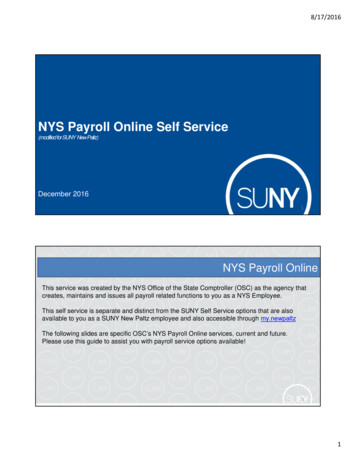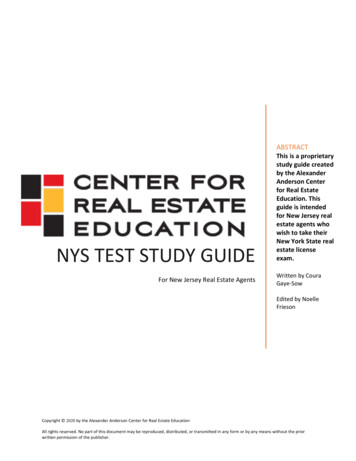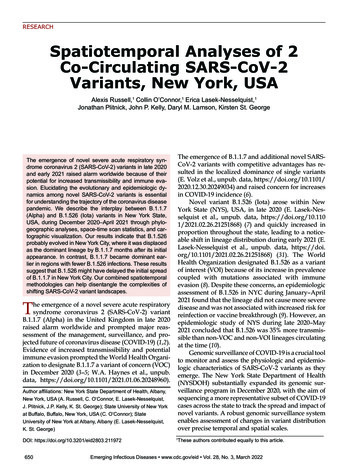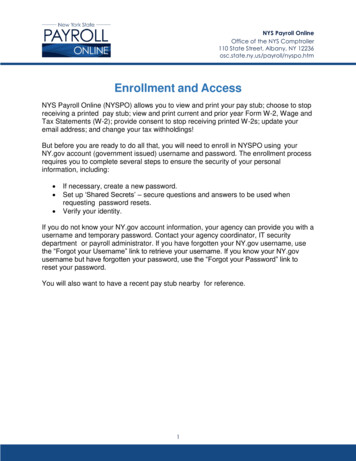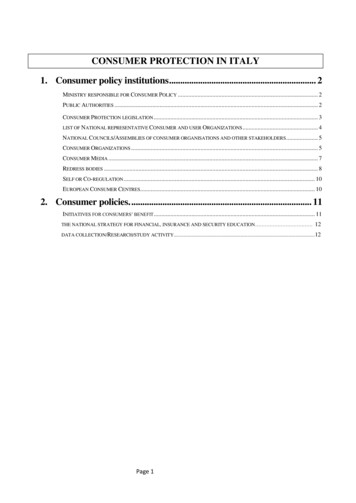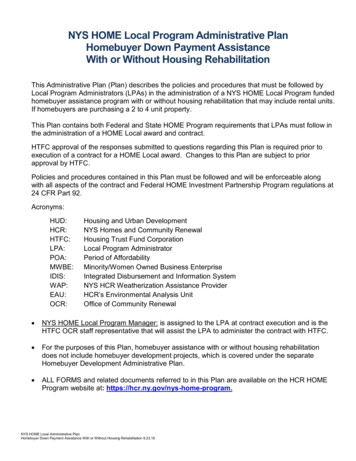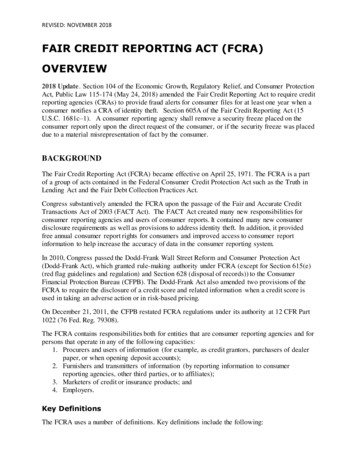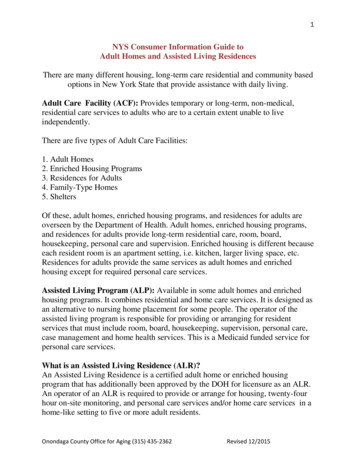
Transcription
1NYS Consumer Information Guide toAdult Homes and Assisted Living ResidencesThere are many different housing, long-term care residential and community basedoptions in New York State that provide assistance with daily living.Adult Care Facility (ACF): Provides temporary or long-term, non-medical,residential care services to adults who are to a certain extent unable to liveindependently.There are five types of Adult Care Facilities:1. Adult Homes2. Enriched Housing Programs3. Residences for Adults4. Family-Type Homes5. SheltersOf these, adult homes, enriched housing programs, and residences for adults areoverseen by the Department of Health. Adult homes, enriched housing programs,and residences for adults provide long-term residential care, room, board,housekeeping, personal care and supervision. Enriched housing is different becauseeach resident room is an apartment setting, i.e. kitchen, larger living space, etc.Residences for adults provide the same services as adult homes and enrichedhousing except for required personal care services.Assisted Living Program (ALP): Available in some adult homes and enrichedhousing programs. It combines residential and home care services. It is designed asan alternative to nursing home placement for some people. The operator of theassisted living program is responsible for providing or arranging for residentservices that must include room, board, housekeeping, supervision, personal care,case management and home health services. This is a Medicaid funded service forpersonal care services.What is an Assisted Living Residence (ALR)?An Assisted Living Residence is a certified adult home or enriched housingprogram that has additionally been approved by the DOH for licensure as an ALR.An operator of an ALR is required to provide or arrange for housing, twenty-fourhour on-site monitoring, and personal care services and/or home care services in ahome-like setting to five or more adult residents.Onondaga County Office for Aging (315) 435-2362Revised 12/2015
2ALRs must also provide daily meals and snacks, case management services, and isrequired to develop an individualized service plan (ISP). The law also providesimportant consumer protections for people who reside in an ALR.ALRs may offer each resident their own room, a small apartment, or a sharedspace with a suitable roommate. Residents will share common areas, such as thedining room or living room, with other people who may also require assistancewith meals, personal care and/or home care services.The philosophy of assisted living emphasizes personal dignity, autonomy,independence, privacy, and freedom of choice. Assisted living residences shouldfacilitate independence and helps individuals to live as independently as possibleand make decisions about how they want to live.Who Operates ALR’s?ALRs can be owned and operated by an individual or a for-profit business group orcorporation, a not-for-profit organization, or a government agency.Paying for an ALRIt is important to ask the ALR what kind of payment it accepts. Many ALRs acceptprivate payment or long term care insurance, and some accept SupplementalSecurity Income (SSI) as the primary method of payment. Medicaid and Medicarewill NOT pay for residing in most ALR’s, although they may pay for certainmedical services received while in the ALR. There are some ALR’s that haveAssisted Living Programs that accept Medicaid.Costs vary among ALRs. Much of the variation is due to the types and level ofservices provided and the location and structure of the residence itself.Types of ALR’s and Resident QualificationsThere are three types of ALRs: Basic ALRs (ALR) and Assisted LivingPrograms, Enhanced ALRs (EALR), and Special Need ALRs (SNALR). Theservices provided, offered or permitted vary by type and can vary from residenceto residence. Prospective residents and their representatives should make sure theyunderstand the type of ALR, and be involved in the ISP process (described below),to ensure that the services to be provided are truly what the individual needs anddesires.Onondaga County Office for Aging (315) 435-2362Revised 12/2015
3Basic ALR: A Basic ALR takes care of residents who are medically stable.Residents need to have an annual physical exam, and may need routine medicalvisits provided by medical personnel onsite or in the community.Generally, individuals who are appropriately served in a Basic ALR are those who: Prefer to live in a social and supportive environment with 24-hoursupervision; Have needs that can be safely met in an ALR; May be visually or hearing impaired; May require some assistance with toileting, bathing, grooming, dressing oreating; Can walk or use a wheelchair alone or occasionally with assistance fromanother person, and can self-transfer; Can accept direction from others in time of emergency; Do not have a medical condition that requires 24-hour skilled nursing andmedical care; or Do not pose a danger to themselves or others.The Basic ALR is designed to meet the individual’s social and residential needs,while also encouraging and assisting with activities of daily living (ADLs).A licensed Assisted Living Program offers all of the above and has one/two personassists/more medical care and accepts Medicaid. A licensed ALR may also becertified as an Enhanced Assisted Living Residence (EALR) and/or Special NeedsAssisted Living Residence (SNALR) and may provide additional support servicesas described below.Enhanced ALR (EALR): Enhanced ALRs are certified to offer an enhancedlevel of care to serve people who wish to remain in the residence as they have agerelated difficulties beyond what a Basic ALR can provide. To enter an EALR, aperson can “age in place” in a Basic ALR or enter directly from the community oranother setting. If the goal is to “age-in- place,” it is important to ask how manybeds are certified as enhanced and how your future needs will be met.People in an Enhanced ALR may require assistance to get out of a chair, need theassistance of another to walk or use stairs, need assistance with medical equipment,and/or need assistance to manage chronic urinary or bowel incontinence.Onondaga County Office for Aging (315) 435-2362Revised 12/2015
4An example of a person who may be eligible for the Enhanced ALR level of care issomeone with a condition such as severe arthritis who needs help with meals andwalking. If he or she later becomes confined to a wheelchair and needs helptransferring, they can remain in the Enhanced ALR.The Enhanced ALR must assure that the nursing and medical needs of theresident can be met in the facility. If a resident comes to need 24-hour medical orskilled nursing care, he/she would need to be transferred to a nursing facility orhospital unless all the criteria below are met:a) The resident hires 24-hour appropriate nursing and medical care to meet theirneeds;b) The resident's physician and home care services agency decide his/her care canbe safely delivered in the Enhanced ALR;c) The operator agrees to provide services or arrange for services and is willing tocoordinate care; andd) The resident agrees with the plan.Special Needs ALR (SNALR): Some ALRs may also be certified to servepeople with special needs, for example Alzheimer’s disease or other types ofdementia. Special Needs ALRs have submitted plans for specialized services,environmental features, and staffing levels that have been approved by the NewYork State Department of Health.The services offered by these homes are tailored to the unique needs of the peoplethey serve. Sometimes people with dementia may not need the more specializedservices required in a Special Needs ALR, however, if the degree of dementiarequires that the person be in a secured environment, or services must be highlyspecialized to address their needs, they may need the services and environmentalfeatures only available in a Special Needs ALR. The individual’s physician and/orrepresentative and ALR staff can help the person decide the right level of services.An example of a person who could be in a Special Needs ALR, is one whodevelops dementia with associated problems, needs 24-hour supervision, and needsadditional help completing his or her activities of daily living. The Special NeedsALR is required to have a specialized plan to address the person’s behavioralchanges caused by dementia. Some of these changes may present a danger to theperson or others in the Special Needs ALR. Often such residents are providedmedical, social or neuro-behavioral care. If the symptoms become unmanageabledespite modifications to the care plan, a person may need to move to another levelOnondaga County Office for Aging (315) 435-2362Revised 12/2015
5of care where his or her needs can be safely met. The ALR’s case manager isresponsible to assist residents to find the right residential setting to safely meettheir needs.Onondaga County Office for Aging (315) 435-2362Revised 12/2015
6Onondaga County Office for Aging (315) 435-2362Revised 12/2015
7How to Choose an ALRVisiting ALR’s: Be sure to visit several ALRs before making a decision to applyfor residence. Look around, talk to residents and staff and ask lots of questions.Selecting a home needs to be comfortable.Ask to examine an “open” or “model” unit and look for features that will supportliving safely and independently. If certain features are desirable or required, askbuilding management if they are available or can be installed. Remember chargesmay be added for any special modifications requested.It is important to keep in mind what to expect from a residence. It is a good idea toprepare a list of questions before the visit. Also, taking notes and writing downlikes or dislike about each residence is helpful to review before making a decision.Things to Consider: When thinking about whether a particular ALR or any othertype of community-based housing is right, here are some things to think aboutbefore making a final choice.Location: Is the residence close to family and friends?Licensure/Certification: Find out the type of license/certification a residence hasand if that certification will enable the facility to meet current and future needs.Costs: How much will it cost to live at the residence? What other costs orcharges, such as dry cleaning, cable television, etc., might be additional? Willthese costs change?Transportation: What transportation is available from the residence? What choicesare there for people to schedule outings other than to medical appointments or tripsby the residence or other group trips? What is within safe walking distance(shopping, park, library, bank, etc.)?Place of worship: Are there religious services available at the residence? Is theresidence near places of worship?Social organizations: Is the residence near civic or social organizations so thatactive participation is possible?Onondaga County Office for Aging (315) 435-2362Revised 12/2015
8Shopping: Are there grocery stores or shopping centers nearby? What other type ofshopping is enjoyed?Activities: What kinds of social activities are available at the residence? Are thereplanned outings which are of interest? Is participation in activities required?Other residents: Other ALR residents will be neighbors, is this a significant issueor change from current living arrangement?Staff: Are staff professional, helpful, knowledgeable and friendly?Resident Satisfaction: Does the residence have a policy for taking suggestions andmaking improvements for the residents?Current and future needs: Think about current assistance or services as well asthose needed in several years. Is there assistance to get the services needed fromother agencies or are the services available on site?If the residence offers fewer Special Needs beds and/or Enhanced Assisted Livingbeds than the total capacity of the residence, how are these beds made available tocurrent or new residents? Under what conditions require leaving the residence,such as for financial or for health reasons? Will room or apartment changes berequired due to health changes? What is the residence’s policy if the monthly feeis too high or if the amount and/or type of care needs increase?Medical services: Will the location of the facility allow continued use of currentmedical personnel?Meals: During visit, eat a meal. This will address the quality and type of foodavailable. If, for cultural or medical reasons, a special diet is required, can thesetypes of meals be prepared?Communication: If English is not the first language and/or there is some difficultycommunicating, is there staff available to communicate in the language necessary?If is difficulty hearing, is there staff to assist in communicating with others?Guests: Are overnight visits by guests allowed? Does the residence have any rulesabout these visits? Can a visitor dine and pay for a meal? Is there a separate areafor private meals or gatherings to celebrate a special occasion with relatives?Onondaga County Office for Aging (315) 435-2362Revised 12/2015
9Who Can Help You Choose an ALR? When deciding on which ALR is right, talkto family members and friends. If they make visits to the residences, they may seesomething different, so ask for feedback.Physicians may be able to make some recommendations about things that shouldbe included in any residence. A physician who knows about health needs and isaware of any limitations can provide advice on your current and future needs.Before making any final decisions, talking to a financial advisor and/or attorneymay be appropriate. Since there are costs involved, a financial advisor may provideinformation on how these costs may affect your long term financial outlook. Anattorney review of any documents may also be valuable. (e.g., residencyagreement, application, etc.).Admission Criteria and Individualized Service Plans (ISP)An evaluation is required before admission to determine eligibility for an ALR.The admission criteria can vary based on the type of ALR. Applicants will beasked to provide results of a physical exam from within 30 days prior to admissionthat includes a medical, functional, and mental health assessment (whereappropriate or required). This assessment will be reviewed as part of theIndividualized Service Plan (ISP) that an ALR must develop for each resident.The ISP is the “blueprint” for services required by the resident. It describes theservices that need to be provided to the resident, and how and by whom thoseservices will be provided. The ISP is developed when the resident is admitted tothe ALR, with the input of the resident and his or her representative, physician, andthe home health care agency, if appropriate. Because it is based on the medical,nutritional, social and everyday life needs of the individual, the ISP must bereviewed and revised as those needs change, but at least every six months.Applying to an ALRThe following are part of entering an ALR:An Assessment: Medical, Functional and Mental: A current physical examinationthat includes a medical, functional and mental health evaluation (where appropriateor required) to determine what care is needed. This must be completed by aphysician 30 days prior to admission. Check with staff at the residence for therequired form.Onondaga County Office for Aging (315) 435-2362Revised 12/2015
10An application and any other documents that must be signed at admission (getthese from the residence). Each residence may have different documents. Revieweach one of them and get the answers to any questions.Residency Agreement (contract): All ALR operators are required to complete aresidency agreement with each new resident at the time of admission to the ALR.The ALR staff must disclose adequate and accurate information about living in thatresidence. This agreement determines the specific services that will be providedand the cost. The residency agreement must include the type of livingarrangements agreed to (e.g., a private room or apartment); services (e.g., dining,housekeeping); admission requirements and the conditions which would requiretransfer; all fees and refund policies; rules of the residence, termination anddischarge policies; and resident rights and responsibilities.Review the residency agreement very carefully. There may be differences in eachALR’s residency agreement, but they have to be approved by the Department.Write down any questions or concerns and discuss with the administrator of theALR. Contact the Department of Health with questions about the residencyagreement. (See number under information and complaints)Disclosure Statement: This statement includes information that must be madeknown to an individual before signing the residency agreement. This informationshould include: licensure, ownership, availability of health care providers,availability of public funds, the State Health Department toll-free number forreporting complaints, and a statement regarding the availability and telephonenumbers of the state and local long-term care ombudsman services. The disclosurestatement should be reviewed carefully.Financial Information: Ask what types of financial documents are needed (bankstatements, long term care insurance policies, etc.). Decide how much financing isneeded in order to qualify to live in the ALR. Does the residence require a depositor fee before moving in? Is the fee refundable, and, if so, what are the conditionsfor the refund?Before Signing Anything: Review all agreements before signing anything. A legalreview of the documents may provide greater understanding. Understand any longterm care insurance benefits. Consider a health care proxy or other advancedirective, making a decision about executing a will or granting power of attorneyto a significant other may be appropriate at this time.Onondaga County Office for Aging (315) 435-2362Revised 12/2015
11Licensing and Oversight - ALRs and other adult care facilities are licensed andinspected every 12 to 18 months by the New York State Department of Health. AnALR is required to follow rules and regulations and to renew its license every twoyears.Glossary of TermsActivities of Daily Living (ADL): Physical functions that a person performs everyday that usually include dressing, eating, bathing, toileting, and transferring.Adult Day Program: Programs designed to promote socialization for people withno significant medical needs who may benefit from companionship andsupervision. Some programs provide specially designed recreational andtherapeutic activities, which encourage and improve daily living skills andcognitive abilities, reduce stress, and promote capabilities.Adult Day Health Care: Medically-supervised services for people with physicalor mental health impairment (examples: children, people with dementia, or AIDSpatients). Services include: nursing, transportation, leisure activities, physicaltherapy, speech pathology, nutrition assessment, occupational therapy, medicalsocial services, psychosocial assessment, rehabilitation and socialization, nursingevaluation and treatment, coordination of referrals for outpatient health, and dentalservices.Aging in Place: Accommodating a resident’s changing needs and preferences toallow the resident to remain in the residence as long as possible.Disclosure Statement: Information made known to an individual before signing theresidency agreement. This information should include: licensure, ownership,availability of health care providers, availability of public funds, the State HealthDepartment toll-free number for reporting complaints, and a statement regardingthe availability and telephone numbers of the state and local long-term careombudsman services.Health Care Facility: All hospitals and nursing homes licensed by the New YorkState Department of Health.Health Care Proxy: Appointing a health care agent to make health care decisionsfor you and to make sure your wishes are followed if you lose the ability to makethese decisions yourself.Onondaga County Office for Aging (315) 435-2362Revised 12/2015
12Home Care: Health or medically related services provided by a home careservices agency to people in their homes, including adult homes, enriched housing,and ALRs. Home care can meet many needs, from help with household chores andpersonal care like dressing, shopping, eating and bathing, to nursing care andphysical, occupational, or speech therapy.Instrumental Activities of Daily Living (IADL’s): Functions that involve managingone’s affairs and performing tasks of everyday living, such as preparing meals,taking medications, walking outside, using a telephone, managing money,shopping and housekeeping.Long Term Care Ombudsman Program: A statewide program administered by theNew York State Office for the Aging. It has local coordinators and certifiedombudsmen who help resolve problems of residents in adult care facilities, assistedliving residences, and skilled nursing facilities. In many cases, a New York Statecertified ombudsman is assigned to visit a facility on a weekly basis.Monitoring: Observing for changes in physical, social, or psychological wellbeing.Personal Care: Services to assist with personal hygiene, dressing, feeding, andhousehold tasks essential to a person's daily living.Rehabilitation Center: A facility that provides occupational, physical, audiology,and speech therapies to restore physical function as much as possible and/or helppeople adjust or compensate for loss of function.Supplemental Security Income (SSI): A federal income supplement programfunded by general tax revenues (not Social Security taxes). It is designed to helpaged, blind, and disabled people, who have little or no income; and it provides cashto meet basic needs for food, clothing and shelter. Some, but not all, ALRs mayaccept SSI as payment for food and shelter services.Supervision: Knowing the general whereabouts of each resident, monitoringresidents to identify changes in behavior or appearance and guidance to helpresidents to perform basic activities of daily living.Onondaga County Office for Aging (315) 435-2362Revised 12/2015
Assisted Living Program (ALP): Available in some adult homes and enriched housing programs. It combines residential and home care services. It is designed as an alternative to nursing home placement for some people. The operator of the assisted living program is responsible for providing or arranging for resident
